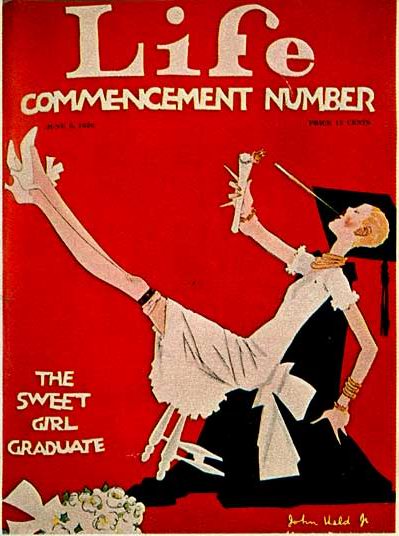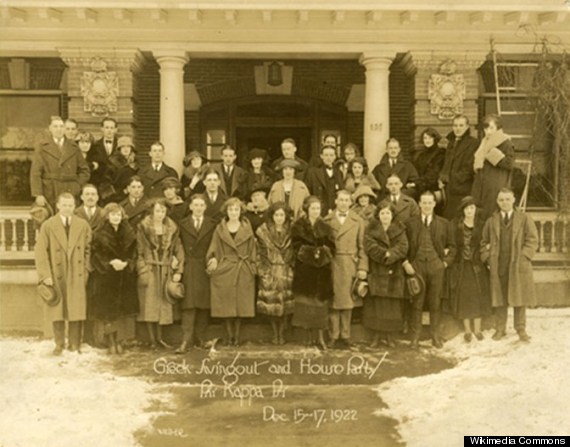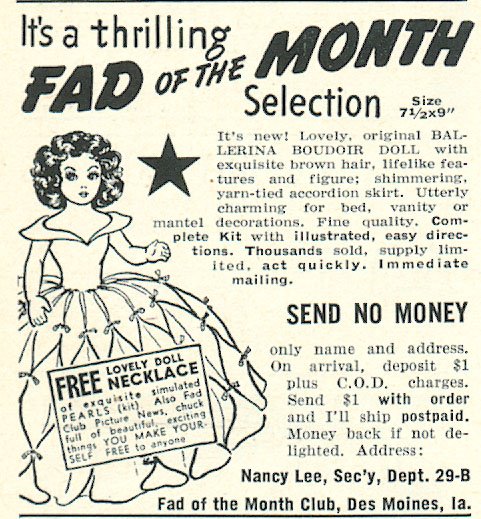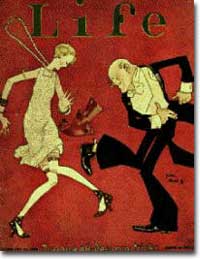To
understand the origins of youth and youth culture in the 1920s, we have to look
at the extension of schooling: the development of high schools and universities
as public institutions which not only serve the elite and privileged but also the
masses of youth in the middle class and the working class. We see the
importance of extended schooling in terms of its effect of bringing young
people who are all the same age together in the same space, in the development
of “peer culture.” The young people don’t have to work or build a career yet,
and they are young so they want to have fun, be entertained, also find their
identity, express themselves at the same time that they want to be part of the
group and “fit in.” And some of them—not all but a lot of them—are also young
and want to experiment with their sexuality, and find some means of getting intoxicated
through alcohol/drugs.
Two
peer cultures which developed and expanded during the 1920s. The first is the
greek system of fraternities and sororities which expanded as the universities
and high schools expanded in the 1920s, along with college football and sports
and a series of fads and fashions which involved how one could dress
“collegiate,” master the “collegiate look.” The second peer culture involves
the culture which developed outside of school, at night on weekends and in
movie houses and jazz clubs and places of amusement. It is here that we see
changes in attitudes about sexuality and gender roles, the emergence of the
“dating” system and increasing rates of premarital intercourse, a series of
changes which had their most profound effects on young women. One indication of
those changes is the emergence of a subculture of “flappers,” which we see as a sign, symbol of the
changes taking place with respect to young women, sexuality, and gender. The
flappers were based in the jazz clubs during Prohibition, and they also represent
important developments in race and its relationship to music made by
African-Americans.
These
youth cultures which developed during the 1920s were eventually stifled by the
events that followed, the Great Depression and WWII. Young people no longer
able to insulate themselves from work and responsibility, they had to “grow up
fast” while looking for a job or fighting a war. Not until the 1950s would
young people and youth culture be as visible in American culture, and by that
time it would be continuous but also bigger than ever.
Many
high schools and universities were founded during the 18th and 19th
centuries across U.S, but they mostly serviced the elite. Private colleges in
particular were places where rich went to become “refined,” how to do things
like learn Latin, which has no practical application in the real world but is a
way of showing privilege. They went to college for religious study. Colleges
were private, expensive, but most of all you had to have the privilege of not
needing to work to help your family. In the year 1900, only 1 of 9 of 14-17
year-olds were in high school, and much fewer in college. The vast majority of
teenagers worked on farms to support their family or maybe even feed their own
family, or they worked in a factory or somewhere else because the family needed
their earnings.
Enrollments
in high school and college began to rise steadily in late 19th and
early 20th century, but 1920 was biggest period of growth. In 1920,
there were 2.2 million HS students, but by 1930 that number had nearly doubled
to 4.3 million HS students. In 1920, 28% of American youth had attended at
least some high school; by 1930 it was 47%. Colleges also saw their enrollments
triple within a 30 year span, from 1900 to 1930. By 1930, 20% of people in late
teens and early twenties were in college. College was still relatively
exclusive to the middle class and some segments of white working class, while far
fewer numbers of blacks and racial minorities were attending. Actually more
women (slightly) than men enrolled, because men’s labor was more likely to be
valuable.
 |
Why
this growth in college enrollment? The 1920s saw a tremendous expansion of
middle class, which had been growing for some time but accelerated its growth in
the 1920s. The new middle classes were based on “white-collar” jobs, jobs not
in manual labor but insurance, sales, management, engineering, or the
professions. This sector of the American population experienced much prosperity
throughout the 1920s, as wages and incomes increased steadily, the stock market
prospered, and the consumer economy flourished as people had more money to
spend. The new middle class was based on white collar jobs in corporations,
based not on physical skill, but rather on information, knowledge,
organization, leadership, services, decision-making, or in other words mental
and social skills. Corporations wanted people with more training in
intellectual skills, with more years of schooling. In turn, people in the
middle classes and the working classes who wanted their children to have a
better future for themselves saw that schooling was the path to upward
mobility, the best and maybe the only way of moving into a white collar or
professional career. So if families could at all afford to send their child to
high school and college, if they didn’t
need their child to work to help support the family, they would send them to
school in hopes that it would give them more opportunities for the future.
One
crucial consequence of the extension of schooling is not only that it allowed
more people to reach or at least aspire to middle class life, but also that it
brought people the same age together in one space. It created the conditions
for a “peer culture” by concentrating them in school. At school, young people
were away from their family (maybe even living at school), they were surrounded
by people their own age, and they were relatively autonomous from institutional
authority. All schools certainly had and still have an elaborate number of
rules and regulations and disciplinary measures and rules of conduct and dress
and authorities (teachers, deans, etc.) who are in charge of watching over
young people. But they are less stringent than in something like the military,
where young people are concentrated together but have absolutely no freedom to
act on their own, and this is why sociologists call the military a “total
institution,” as opposed to high schools and colleges.
 |
The
first “peer culture” in relation to school. These were mostly school clubs based
on extra-curricular activities. High schools and colleges saw students become
involved in after-school dances, drama clubs, glee clubs and choruses, as well
as participation in student government and student newspapers, and all kinds of
different religious and ethnic organizations. These student groups tended to
act as a bridge between family and adulthood for young people, providing them
with emotional support and friendship and security among their peers and thus
easing the removal from one’s family, while at the same time giving young
people opportunities to make their decisions, work together as a group, and
participate in ways that they couldn’t do in the classroom.
The
most important and central of these school-based peer cultures was the greek
system of fraternities and sororities, which were closely connected to school
athletics and team sports, the most popular of which was football. Again,
fraternities and sororities had been around long before the 1920s, on both HS
and college campuses, but the 1920s was when they experienced an extraordinary
growth as enrollments increased. The number of fraternity chapters increased
from 1,500 in 1912 to 4,000 in 1930. The number of fraternity houses increased
from 750 in 1920 to 2,000 in 1930. By 1930, 35% of college students were in
fraternities and sororities.
 |
Greeks
were thus a minority, but on many campuses they became a very powerful and
influential one. At most schools they dominated student government and, by
extension, student newspapers. In fact, most elections were simply choices
between different fraternities and sororities. As they received more alumni
donations and build more houses around campus, they also began to wield
considerable financial and political power. By 1929 the estimated value of all
greek-owned property was said to be $90 million.
But
the place where Greeks probably exercised the most power and influence was over
the social scene, the peer culture of young people on campus. Fraternities and
sororities built their reputation based on having the most popular, the most
important, the most attractive, people. As enrollments and pledges increased,
the Greeks could afford to be more and more selective, and their reputation in
fact hinged on being the most exclusive, the most selective. Because of their
power in student government and newspapers, they could increase their own
status and prestige by electing their people to positions of power or writing
articles in the school paper about the “big man on campus.”
The
most important way that frats and sororities enhanced their prestige and status on
campus was through linking themselves to college football. The 1920s saw an
explosion in interest and popularity in football at the college and high school
levels. Football was popular because it resolved people’s anxieties about
masculinity in the 1920s: young men were no longer fighting at war, nor were
they working in factories or farms, but instead they were in school, an
activity that at the time had feminizing connotations. So people were basically
afraid that little Johnny would go off to school and come back a pansy, and
football helped eased those anxieties because it was so masculine and violent,
a sport that most closely approximated warfare. Football also helped galvanize
people’s sense of “school of spirit,” their sense of belonging to something larger
than themselves, being part of the glory of their institution. When the team
won, they won. During the 1920s students would often travel with the football
team for games at other campuses, taking a “road trip” from Ann
Arbor to Evanston to see Michigan
Fraternities
and sororities latched on to the power and popularity of college football
during the 1920s. They aggressively recruited the best and most attractive
players and cheerleaders among themselves. When people on campus thought of a
particular fraternity or sorority, they often associated it with an individual
player or cheerleader.
Because
they were seen as powerful, because they had a reputation, status, and prestige,
most students invariably wanted to be part of the Greek system. Most students
had been sent to college in order to become “successful,” and fraternities and
sororities were the most immediate symbols of success. Sometimes the benefits
of belonging were economic, because of the connections that alumni might have
with business or government. But the Greek system was also crucial for things
like the dating scene, where one’s attractiveness and desirabilitiy of course
resided in which fraternity or sorority one belonged to. If you needed a date
for the big dance and didn’t belong to a reputable house, you were probably out
of luck.
|
Because
enrollments were increasing rapidly and because so many of those new students
wanted to be part of the Greek system, and because the fraternities and
sororities based their reputation on being selective and exclusive, the campus
peer culture of the 1920s was extremely conformist and hierarchical. If you
wanted in, you had to talk the same, dress the same, act the same, and share
the same values, ideas, and attitudes as your peers. If you were too weird, if
you didn’t show enough “school spirit,” if you had too many intellectual
interests and not enough extra-curricular ones (not to mention if you were not
attractive, or Jewish, or black), you could be easily discarded and left out.
 |
This
pressure to fit in and keep up with one’s peers became even more intense during
the 1920s with the introduction of “fads” and various “collegiate” fashions.
Now students not only had to keep up with their peers but also stay informed
about the newest fashion, the latest dance craze, and so on. College newspapers
circulated reports about what the students at Yale or Harvard were wearing.
Advertisers began to target college students because their numbers were
becoming larger and they had money to spend. Advertisers could exploit young
people’s anxieties about “fitting in” with the crowd, asking Didn’t you know
everyone who’s anyone is using X? Wearing Y? Movies and magazines, the newest
media of the 1920s, also helped circulate images of what the young and
successful were doing and wearing. In short, this peer culture on campus was
based on a precarious balance of conforming to group expectations and competing
to be the newest, the hippest, the most modern.
|
 |
A
second form of youth culture became highly visible during the 1920s, and this
one developed outside of school. This doesn’t mean that high school and college
students didn‘t go out to nightclubs, to dance and listen to jazz music, to
drink and mingle with the opposite sex, etc. because they did—middle class
students were an important part of this youth culture also. But this second
youth culture also involved a lot of young people who weren’t students,
working-class youth who were the children of immigrants, who lived in cities
but didn’t go to school and had to work in their teenage years.
The
late 19th and early 20th centuries were an important
period of change for young people, even if they didn’t have the opportunity to
go to school. This was the period of industrialization, and the demand for
labor drew many families to migrate to the American cities, either from rural America or somewhere outside the US New York
 |
The
system of dating, going on dates, as we know it, emerged during the 1920s among
young people. Previously, courtship had been strictly chaperoned: young people
could go out with the opposite sex, but they had to bring an adult or be
subjected to adult approval. The date was different because it was relatively
unsupervised. The availability of the automobile was crucial to this freedom,
as the date involved going out somewhere, and the automobile might also be the
place where the couple ended up if things got serious. Sometime in between, the
couple had to have somewhere to go, and dance halls and amusement halls were
certainly popular, but the most popular destination was the movie theater.
Going to the movies, after all, not only meant going out but also sitting alone
in a dark theater.
The
movie theater became an important destination for young people—during the 1920s
it was reported that most young people went to the movies about once a week. In
turn, the movie industry began to target
young people as a crucial audience and source of profit. Moviemakers tried to
capitalize on the interest of their youthful audiences with movies about people
their age: in the early 20s, there were several movies with “youth” in their
title produced every year, such as Reckless Youth, Flaming Youth, The Heart of
Youth, The Soul of Youth, The Price of Youth, The Madness of Youth, Youth Must
Have Love, Sporting Youth, Pampered Youth, Cheating Youth, and finally, Too
Much Youth. The movies themselves also became an important means of advertising
to young people, particularly to young women, as fans became interested in what
cosmetics movie stars used, what clothes they wore, what hairstyles they
sported, and so on.
More
generally, the movies provided a perfect advertisement for a life of leisure
and consumption, for a liberalization of sexual mores, for an image of the
“good life” as it appeared to be personified by youth during the “Roaring
Twenties.” This image of the Roaring Twenties was captured by the novelist F.
Scott Fitzgerald, who wrote about an age when young people ruled the scene,
when everyone wanted to get in on the good life and share in prosperity and
consumerism, when people wanted to know what young people were up to so that
they too could be hip to the newest, most modern styles, when youth themselves
were confident, carefree, and turned their backs on adult authorities and
traditions. So the image of youthfulness, especially in the movies, was closely
connected to the prosperity and consumerism of the Roaring Twenties, and to the
way in which the new consumer culture accelerated the rate of change in society
and broke down the repressiveness of the Victorian Era.
Indeed,
during the 1920s, attitudes about sex, family, work, and gender were all
changing, and young women of all class backgrounds were leading the change.
Surveys reveal that young women were losing their virginity at an earlier age,
that more young women were having sex before marriage, and that most of them
did not think of sex as a “sin.” Various magazines began to report about the
practice of “petting” among young people on dates. People became more receptive
to the idea of sex education and information about contraception, and people of
all ages were less likely to view divorce as a source of shame and stigma. The
media tended to inflate and exaggerate the changes in sexual mores and behavior
to create a sense of moral hysteria, but the fact is that attitudes had really
changed.
The
flapper became the symbol of these new freedoms granted to young women and the
liberalization of attitudes about sex. The word flapper was brought home by
American soldiers after World War I who used it to describe European women who
were supposedly looser and more “easy.” The flappers were both a real
subculture of young women and a figment of media sensationalism about sex,
girls, and morality. In other words, they are the first of many American
subcultures—like juvenile delinquents, beats, hippies, and punks—which have
some basis in reality, and then are hyped up in the media, which causes more
young people to want to be a part of them because the media gives the
subculture a reputation for being bad, rebellious, etc.

The
flapper look and style was characterized by bobbed hair, short skirts, silk
stockings, and heavy cosmetics. It was a conscious turn away from the image of
femininity in the Victorian era, when girls were made to look like flowers,
with frilly dresses and long hair. The flapper look was more aggressively
sexual, but the short hair and slimming fashions also gave it an androgynous
appearance. The flapper style became synonymous with the modern look, with the
style which moved away from traditional styles of fragile femininity. The
behavior of flappers also suggested a breaking with tradition in regard to
gender norms: flappers got attention because they smoked and drank in public (these
were big no no’s), because they danced with men in dance halls, and because
they had a reputation for going all the way before marriage.
The
place where flappers could be found was in nightclubs, dancing to jazz music,
leading a series of dance crazes like the turkey trot, the bunny hug, “shaking
the shimmy.” Beginning in the year 1920, the
|
 |
Dancing to jazz music and
going to speakeasies became immensely popular not only with flappers but with
all kinds of young people who were looking for a good time and a chance to
rebel. This touched off a moral panic among adult authorities, who were
predictably troubled by the sexuality of youthful dancing, especially within a
racially integrated establishment. In the early twenties, the Ladies Home
Journal warned its readers that young people were
being morally corrupted as they danced along to "the abominable jazz
orchestra with its voodoo-born minors and its direct appeal to the sensory
center." Notice the blatant racism in this warning—the description
of music made by blacks as “voodoo music,” the assumption that black music is
primitive, sensual, can somehow inflitrate the body and make it “wriggle.” This
was of course the main fear of white America about jazz, dancing, and
speakeasies: that black music might corrupt young girls by appealing to their
sensuality, that on an intergrated dance floor young white girls might “wriggle
their torso” with young black boys. This is a common formula for moral panic,
which we will see repeated in the 1950s with regard to rock ‘n’ roll: it is
basically the fear that comes when young white kids listen to black music.
You
might also notice that the young people themselves also found music and dancing
to be exciting and rebellious because they mostly shared their parents’ racist
assumptions. The parents thought that the music and dancing was primitive,
sensual, and exotic and that this was a bad thing. The kids also thought the
jazz scene and its people were primitive, sensual, and exotic, but this was
exactly what they wanted. In other words, they shared their parents’
assumptions, but reached different conclusions. They wanted to rebel or escape
from civilized, so they latched on to a people and a music which they assumed
to be uncivilized, primitive and exotic. This established a pattern of white
appropriation of black music which we will see repeated at several different
points during the twentieth century.
|
 |
| Add caption |

No comments:
Post a Comment